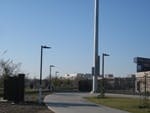Lumewave announced that it supplied the network and controls technology for an outdoor LED-based lighting system located on the University of California at Davis (UC Davis) campus. The California Technology Lighting Center (CLTC) located at UC Davis led the solid-state lighting (SSL) project that encompasses 1400 wall-pack, post-top and pathway lights.
Like most controls-based lighting installations, the UC Davis project was designed to optimize energy savings by combing efficient LED sources with dimming to further reduce energy usage. The project encompasses walkways and pathways, but not roadways with automobile traffic at this point.
Kelly Cunningham, the outreach director at the CLTC, actually disclosed some facts about the installation at the recent Street and Area Lighting Conference (SALC), without discussing the details of the network components. Watch for our November/December issue of LEDs Magazine for detailed coverage of that talk.
According to Lumewave, the installation utilizes the company's TOP900-TL wireless-enabled control modules installed in each luminaire. Those modules can control the drivers in the LED luminaires and interface to motion sensors supplied by WattStopper for installation with each fixture.
At SALC, Cunningham described how the system uses input from a series of sensors to determine the direction that an object such as a bicyclist is travelling, and the speed of travel. That intelligence allows the system to bring a light to full brightness as the bicyclist approaches each light. A simple motion sensor that directly controls a light would not react to the bicyclist until it had passed the light pole.
Lumewave says that the system utilizes "Adaptive Control with Predictive Behavior" technology. The company describes the "direction of travel" function as patented. A peer-to-peer wireless network allows the lights to sequentially brighten in sequence with a moving object and dim as the object leaves an area.
The lighting retrofit cost UC Davis $950,000 according to Lumewave, but the company says that the a campus will save $100,000 per year in energy costs. Lumewave also said that the controls add 40% in energy savings to the baseline savings afforded by the transition to SSL.
At SALC, Cunningham said that in the case of the wall packs, the transition to LEDs generated 87% in savings and then the controls added an additional 20% in savings. The biggest impact came in the pathway lights where the controls added 34% in savings according to Cunningham.







